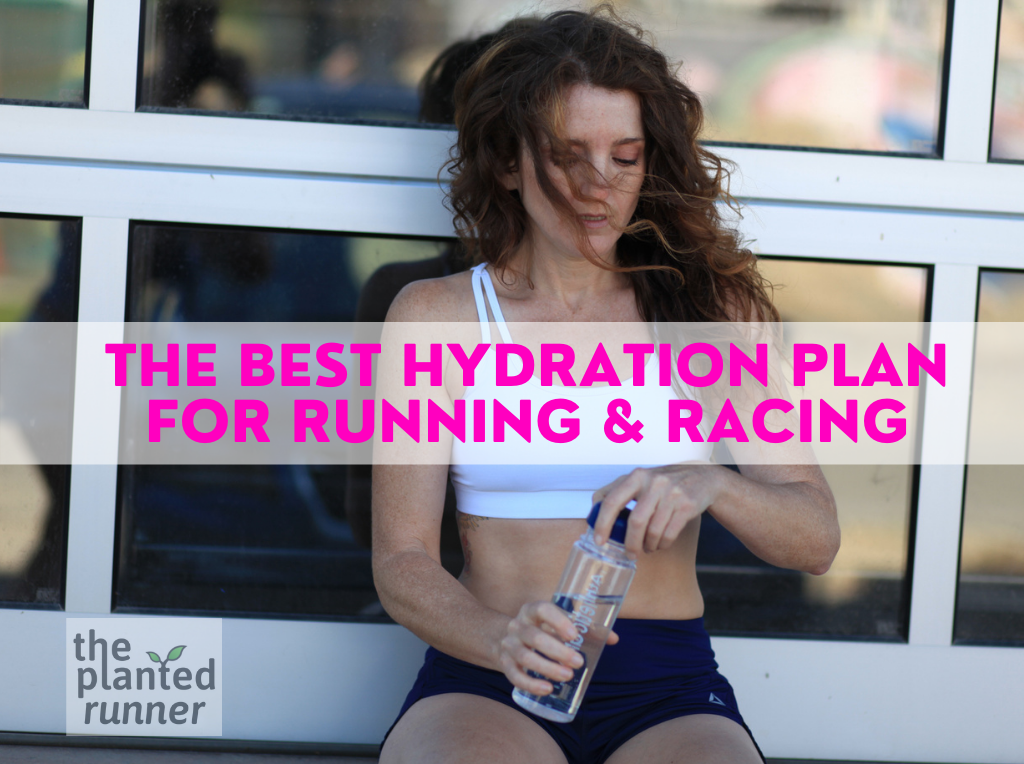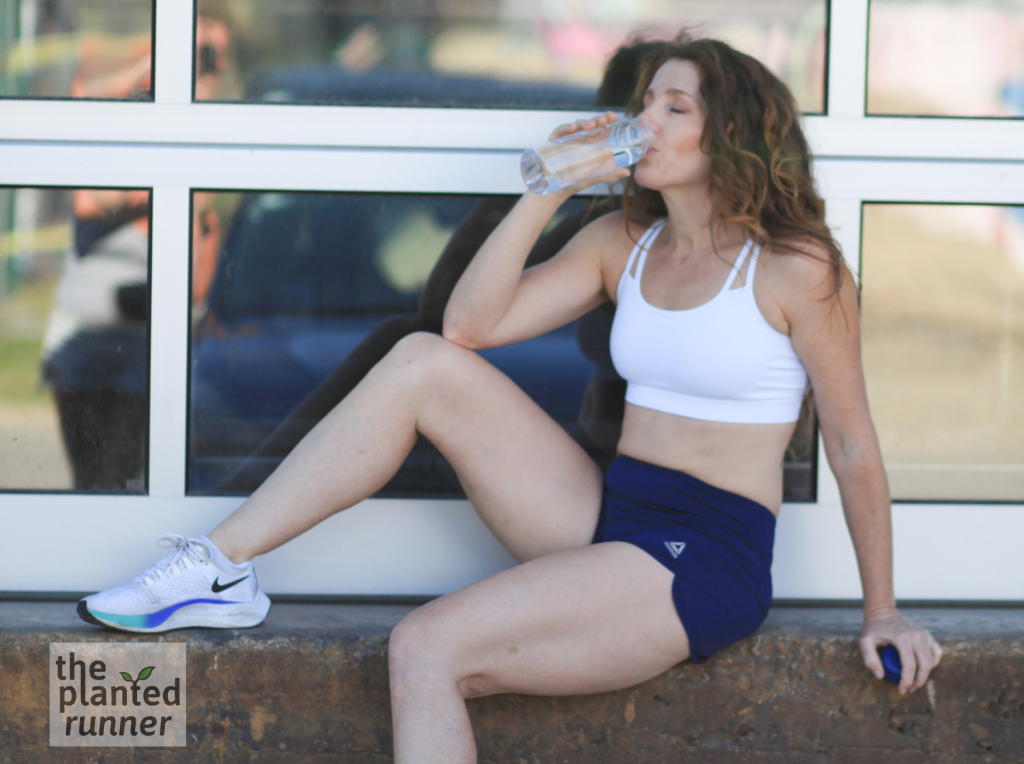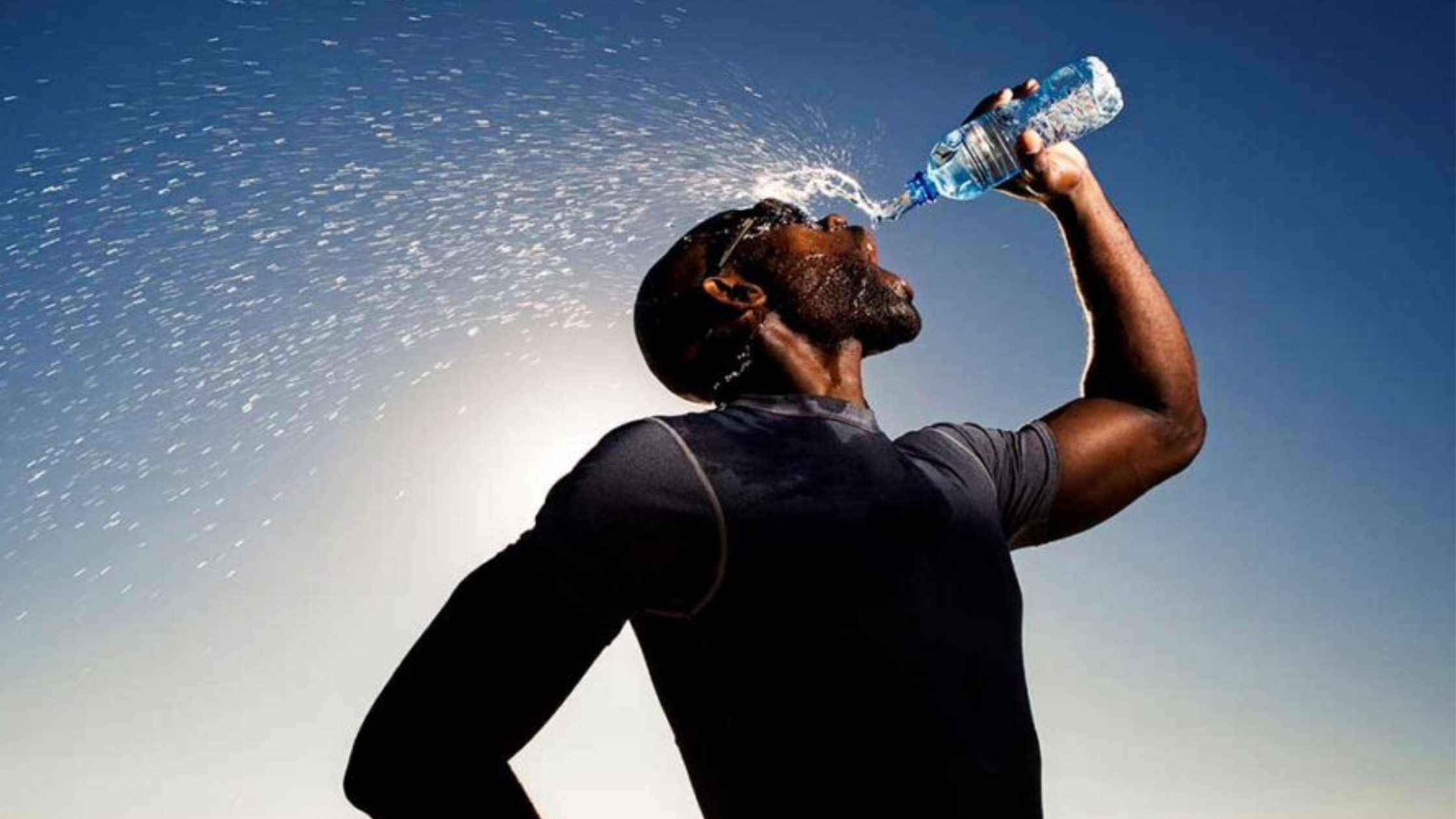Ah, summer. The warm, sunny days, and short nights are perfect for getting outside and savoring nature with family and friends. But if you are an endurance runner, you’ll need a hydration plan for hot running and racing.
Not only is running simply more uncomfortable as the mercury rises, but the combination of heat, sun, humidity and distance will begin to affect our performance as the body struggles to cool itself down.
If you’ve ever come back from a run soaked in sweat, or had salt stinging your eyes and staining your clothes, you probably already know that hydration is important. And if you are training this summer for a marathon or an ultra, a solid hydration plan is an absolute must.

Runs and Races Under 60 Minutes
If your runs, workouts, or races are less than an hour, even if you are sweating puddles, coming up with a perfect hydration protocol is not super important to health and performance. You do not need to replenish with gallons of Gatorade after a short jog or a sweaty strength session. Simply drinking to thirst when you are done with the run is usually sufficient to bring your fluid levels back to normal.
And it’s easy to recharge your electrolyte balance with healthy whole foods after your workout, no special drinks or solutions required. If you notice that you are a very salty sweater, enjoying some lightly salted foods after a run will probably do the trick.
But once you get into runs and workouts that go longer than an hour or if you are training for a multi-hour event, it’s time to get a more focused hydration strategy for maximum performance.
Runs and Races Longer Than an Hour
Besides being thirsty and uncomfortable, dehydration will start to affect your performance. Water (along with sodium) is what keeps your blood flowing quickly and easily to your heart, lungs and muscles. Not to mention that it’s essential for every cell in the body to function.
When you become dehydrated, your blood becomes thicker, which makes your heart work harder, which in turn, makes running harder. If you offset your sweat loss by drinking on the run, you can race further and faster without slowing down.
But how do we know exactly how much to drink? And exactly what? Theories on hydration for endurance have vacillated wildly over the years and for the most part, most experts tell us to begin with our thirst.

Drink to Thirst (Sort Of)
Our thirst mechanism is highly attuned to making sure that we maintain homeostasis, or a perfect balance of fluid to electrolytes. When we sweat, we eventually get thirsty and might even crave salt as our body’s signal to eat and drink.
But during a long endurance event, our thirst might not be quite as reliable the longer the race goes on. We are less able to absorb calories and liquids as the blood gets diverted to the skin and away from the gut. So we need to start fueling and hydrating BEFORE we are thirsty.
Here’s my recipe for what I used in my sub-three hour marathon
For most marathons, aid stations are easy to come by and you can plan to drink every 2-3 miles or so, more often if it’s hot. With longer ultras or less-supported races, you’ll want to plan to carry what you need between aid stations.
Either way, a plan is essential.
Plan For Success
The first step is finding out how much you sweat. Most runners already know if they are on the sweatier end of the spectrum, but it’s also a good idea to get some better data on just how much sweat is lost.
Getting a rough idea of your sweat rate is pretty simple. You just weigh yourself naked before a hot run, weigh yourself when you get back, and subtract any liquid you drank on the run. The result is your sweat loss on a similar run. This is not lab-precise because you lost more than just water on the run, but it’s close enough to determine if you are a heavy sweater or not.
Next, you’ll need to figure out how much you need to replace while running. This will be quite subjective because the costs of dehydration are different for everyone. Some runners will get slowed down by as little as a 1% loss of body weight, while other runners can handle up to an 8% sweat loss.
In general, most people do not start to see performance declines until about 3-4%.
Now that does not mean that you want to replace 100% of the fluid you lost. That would lead to a sloshing belly and would probably decrease your ability to run well. So you’ll have to keep experimenting on your runs to find the right amount of liquid you can comfortably handle.
Pre-Hydration
One overlooked part of your hydration plan is to start off fully hydrated. It can make a big difference in how quickly you dehydrate. It is similar to the concept of carb-loading, but because the body cannot store water in the same way it stores fuel, it’s done a little differently.
Andy Blow of Precision Hydration has been one of my favorite guests on The Run To the Top and explains more of exactly how and why to prehydrate here.
The downside of pre-hydrating and carb-loading? Weight gain.
Most runners hate to learn that they should aim to start a race weighed down with water and glycogen. As a coach, I hear from a lot of runners that are worried about how the extra weight will slow them down. But the truth is exactly the opposite. With fully topped off stores of fuel and hydration, you have what you need exactly where you need it, giving you a performance edge.
Sodium is Key
Sodium intake is critical to any hydration plan, but that can be a tough concept to fully embrace, especially among healthy runners that have chosen to follow a healthy lifestyle with naturally low-sodium foods. But unless your doctor specifically has told you to limit your sodium intake, and you’ve told your doctor how much you run, you might want to re-consider the role sodium plays in your running and your diet.
Much like how simple sugars are a bad idea for a sedentary adult, but the perfect fuel for racing, sodium’s impact on dehydration cannot be understated. A typical runner can lose anywhere from 250mg to over 1000mg of sodium per liter of sweat. If you sweat two liters of sweat per hour and you are a salty sweater, you’ve lost almost all of your sodium requirement for the entire day (the RDA is 2300mg)!
That does not give runners a free pass to eat as much sodium as they like, however. But you do need to be aware of its importance to your overall hydration plan for endurance.
While figuring out your sweat rate is pretty straightforward, figuring out your exact sodium loss rate is not quite as simple without a lab test. But research has found that a very subjective self-survey ends up being fairly accurate. In other words, if you think you are a salty sweater–your running clothes have white salt streaks on them or if your sweat stings your eyes when you run–you most likely do have a higher than average sodium loss.
Or you can take Precision Hydration’s FREE test here.
The Rest of the Electrolytes
With all this talk about sodium, you might be wondering what about the rest of the electrolytes? Pick up a bottle of any sports drink designed for endurance and you will see a list of other minerals like potassium, magnesium, and calcium which are all essential electrolytes.
Despite what the bottle says, you don’t need any of those while running, unless perhaps you are running a multi-day stage race. Sodium is king because it’s the only one that is lost in significant quantities in sweat. The rest can be consumed with real food when you are done running.
Test and Tweak
The last step in your perfect hydration plan is to test and experiment as often as you can. Try out a slightly higher sodium drink on your next hot long run and note how it goes. Test it out on a fast workout, even if it is less than an hour long, and see if it makes any difference. Adjust, tweak, and record the results in your training log throughout the summer until you find the combination of fluid to sodium levels that seems to suit you best.
By the time you toe the line of your marathon or ultra, you’ll know your exact hydration needs to produce your best performance. No sweat.

